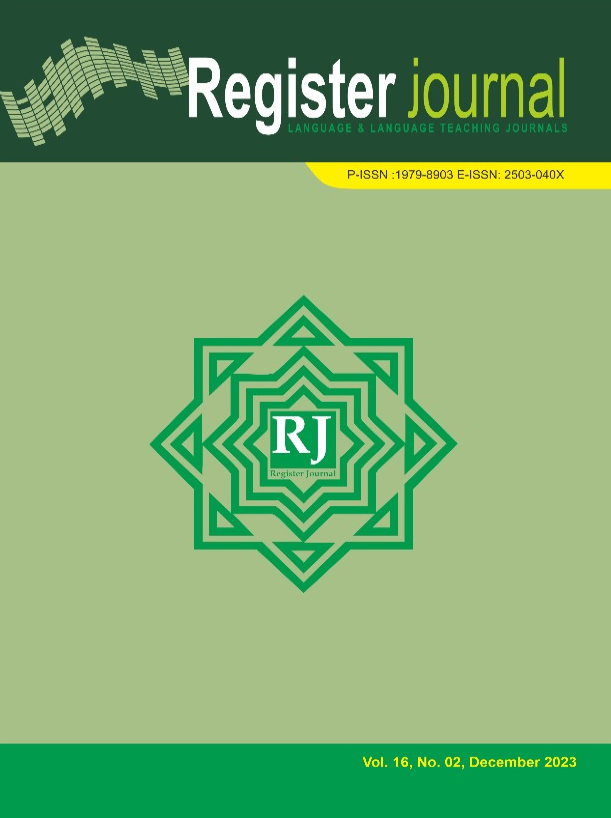Affect and Characterization in Narrative Texts Written by Senior High School Students
DOI:
https://doi.org/10.18326/register.v16i2.323-343Keywords:
affect, quality, process, comment, story, characterizationAbstract
This article discusses the attitudinal lexis representing feelings to support the process of characterization in narrative texts written by senior high school students in Plupuh, Sragen. Six best stories were selected from twenty texts produced by the students to be analyzed for their text structure and for the way the writers exploit the emotive words representing feelings to support the process of characterization for the participants in the stories. The results show that all of the writers have good skills in arranging discourse units to be a narrative text. All of the texts are structured with the obligatory discourse units for a narrative such as Orientiation, Complication, and Resolution. Furthermore, they are also good in selecting the emotive words representing feelings in the forms of Quality and Process. However, they did not have the words in the form of Comment in their stories. The language units representing feelings are distributed along the units of the narrtive texts to support the discourse functions of each unit. Overall, the exploitation of the emotive words can help the writers in the process of characterization of the participants of the stories they produced.
References
References
Ataei, Susan. (2019). Exploring the Emotional Language in the Twilight Novel as a Literary Discourse: An Appraisal Theory Analysis. Purdue Linguistics, Literature, and Second
Ayoun, D. (2005). Parameter Setting in Language Acquisition. London: Continuum.
Cartledge, G. & Kiarie, M.W. (2001). Learning Social Skills through Literature for Children and Adolescents. Dalam Teaching Exceptional Children, Vol. 34, No.2, pp. 40-47.
Ding, A & Bruce, I (2017) The english for academic purposes practitioner: Operating on the edge of academia (Springer)
Djatmika, Primasita, F. A., & Pritanto, A.D. (2012). Strategi Meningkatkan Kualitas Olah Bahasa Untuk Cerita Pendek Tulisan Siswa Sekolah Dasar Dengan Pendekatan Genre-Based. Jurnal Ilmu Bahasa dan Sastra LINGUA (Terakreditasi)
Djatmika. (2012). Kualitas Olah Bahasa Anak Usia Sekolah Dasar dalam Kegiatan Bercerita: Sebuah Proses Pemerolehan Bahasa Anak. Metalingua Jurnal Penelitian Bahasa (Terakreditasi). Vol 10, No 2 Desember 2012
Eggins, S. (1994). An Introduction to Systemic Functional Linguistics. London: Pinter Publishers.
Gerot, L. & Wignell, P. (1994). Making Sense of Functional Grammar. Cammeray: AEE.
Green, C & Lambert, J (2018) Advancing disciplinary literacy through English for academic purposes: Discipline-specific wordlists, collocations and word families for eight secondary subjects J. English Acad. Purp. 35 105–15
Halliday, M. A. K., & Matthiessen, Christian M. I. M. (2014). Halliday's Introduction to Functional Grammar (4th ed.). London & New York: Routledge.
Khlaif Z N, Salha S, Affouneh S, Rashed H and ElKimishy L A (2021) The Covid-19 epidemic: teachers’ responses to school closure in developing countries Technol. Pedagog. Educ. 30 95–109
Lust, B. C. (2006). Child Language: Acquisition and Growth. Cambridge: Cambridge University Press.
Martin, J.R. (1992). English Text: System and Structure. Philadelphia: John Benjamins Publishing Company.
Martin, J. R., & Rose, David. (2007). Working with Discourse: Meaning Beyond the Clause (2nd ed.). New York: Continuum.
Martin, J. R., & White, P. R. R. (2005). The Language of Evalution: Appraisal in English. New York: Palgrave Macmillan.
Onyema E M, Eucheria N C, Obafemi F A, Sen S, Atonye F G, Sharma A and Alsayed A O (2020) Impact of Coronavirus pandemic on education J. Educ. Pract. 11 108–21
Saffran, Jenny. R., Senghas, Ann & Trueswell, John. C. (2001). The acquisition of language by children. Journal of PNAS. November, Vol. 98. No. 23
Santosa, R., Djatmika, & Primasita, F.A. (2007). Sastra Anak Sebagai Wahana Pengenalan Dan Pengasuhan Ideologi: Sebuah Kajian Wacana. Jurnal Penelitian Humaniora Edisi Khusus, Juni 2006
Santosa, Riyadi, Djatmika, Djatmika, & Khrisna, Dyah Ayu Nila. (2021). Genre and attitude to support character development in children stories. Register Journal, 14(1), 83-98.
Thompson, Geoff. (2014). Introducing Functional Grammar. London and New York: Routledge.
Thornborrow, J. & Coates, J.(Eds.) (2005). The Sociolinguistics of Narrative. Amsterdam: John Benjamin Publishing.
Webster, J. (2015). Understanding Verbal Art: A Functional Linguistic Approach. Heidelberg: Springer.
Downloads
Published
How to Cite
Issue
Section
License
Copyright (c) 2023 Djatmika Djatmika, Riyadi Santosa, Tri Wiratno, Rara Sugiarti, Agus Hari Wibowo, Tati Sugiarti, Ulfah Yanuar Lianisyah, Rudiansyah Rudiansyah

This work is licensed under a Creative Commons Attribution-ShareAlike 4.0 International License.
COPYRIGHT NOTICE
REGISTER JOURNAL: https://ejournal.uinsalatiga.ac.id/index.php/register/index is licensed under a Creative Commons Attribution-ShareAlike 4.0 International License
Copyright Notice
An author who publishes in REGISTER JOURNAL agrees to the following terms:
- The author retains the copyright and grants the journal the right of first publication of the work simultaneously licensed under the Creative Commons Attribution-ShareAlike 4.0 License that allows others to share the work with an acknowledgment of the work's authorship and initial publication in this journal
- The author can enter into separate, additional contractual arrangements for the non-exclusive distribution of the journal's published version of the work (e.g., post it to an institutional repository or publish it in a book) with the acknowledgment of its initial publication in this journal.
- The author is permitted and encouraged to post his/her work online (e.g., in institutional repositories or on their website) before and during the submission process, as it can lead to productive exchanges, as well as earlier and greater citation of the published work (See The Effect of Open Access).
Read more about the Creative Commons Attribution-ShareAlike 4.0 Licence here: https://creativecommons.org/licenses/by-sa/4.0/.
Privacy Statement
The names and email addresses entered in this journal site will be used exclusively for the stated purposes of this journal. They will not be made available for any other purpose or to any other party.







